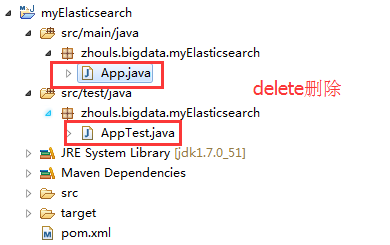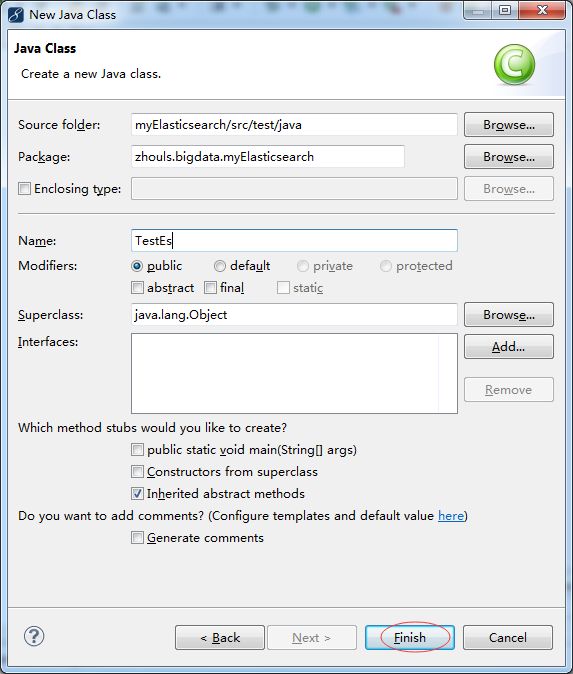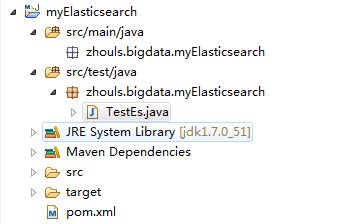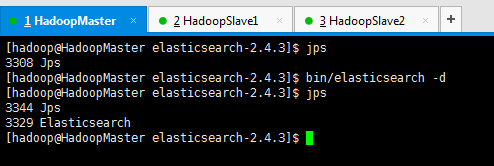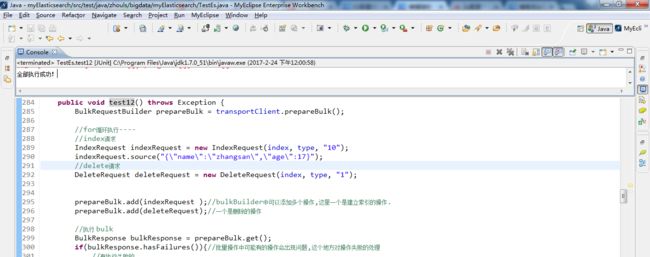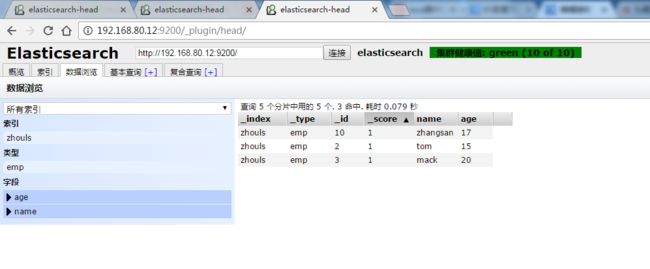Elasticsearch 编程API入门系列
说明:我这里是3台机器组建的es集群,然后编写其代码!
192.168.80.10、192.168.80.11、192.168.80.12
我这里,elasticsearch用的是2.4.X版本。
API文档:https://www.elastic.co/guide/en/elasticsearch/client/java-api/2.4/java-docs.html
删除默认的App.java
以TestEs.java为例
项目结构
通过TransportClient这个类,指定es集群中其中一台或多台机的ip地址和端口
TransportClient client = TransportClient.builder().build().addTransportAddress(new InetSocketTransportAddress (InetAddress.getByName("host1"), 9300)).addTransportAddress(new InetSocketTransportAddress(InetAddress.getByName("host2"), 9300));
如果需要使用其他名称的集群(默认是elasticsearch),需要如下设置
Settings settings = Settings.settingsBuilder().put("cluster.name", "myClusterName").build();
TransportClientclient = TransportClient.builder().settings(settings).build().addTransportAddress(new InetSocketTransportAddress (InetAddress.getByName("host1"), 9300));
通过TransportClient这个接口,自动嗅探整个集群的状态,es会自动把集群中其它机器的ip地址加到客户端中
Settings settings = Settings.settingsBuilder().put("client.transport.sniff", true).build();
TransportClient.builder().settings(settings).build().addTransportAddress(new InetSocketTransportAddress (InetAddress.getByName("host1"), 9300));
索引index(四种json,map,bean,es helper)
IndexResponse response = client.prepareIndex("zhouls", "emp", "1").setSource().get()
查询get
GetResponse response = client.prepareGet("zhouls", "emp", "1").get();
更新update
删除delete
DeleteResponse response = client.prepareDelete("zhouls", "emp", "1").execute().actionGet();
总数count
long count = client.prepareCount("zhouls").get().getCount();
前提
准备,开启3台机器组建的es集群进程
代码编写:
package zhouls.bigdata.myElasticsearch;
import static org.junit.Assert.*;
import java.net.InetAddress;
import java.util.HashMap;
import java.util.List;
import org.elasticsearch.action.bulk.BulkItemResponse;
import org.elasticsearch.action.bulk.BulkRequestBuilder;
import org.elasticsearch.action.bulk.BulkResponse;
import org.elasticsearch.action.delete.DeleteRequest;
import org.elasticsearch.action.get.GetResponse;
import org.elasticsearch.action.index.IndexRequest;
import org.elasticsearch.action.index.IndexResponse;
import org.elasticsearch.action.search.SearchResponse;
import org.elasticsearch.action.search.SearchType;
import org.elasticsearch.action.update.UpdateResponse;
import org.elasticsearch.client.transport.TransportClient;
import org.elasticsearch.cluster.node.DiscoveryNode;
import org.elasticsearch.common.settings.Settings;
import org.elasticsearch.common.transport.InetSocketTransportAddress;
import org.elasticsearch.common.transport.TransportAddress;
import org.elasticsearch.common.xcontent.XContentBuilder;
import org.elasticsearch.common.xcontent.XContentFactory;
import org.elasticsearch.index.query.MatchQueryBuilder.Operator;
import org.elasticsearch.index.query.QueryBuilders;
import org.elasticsearch.search.SearchHit;
import org.elasticsearch.search.SearchHits;
import org.elasticsearch.search.aggregations.Aggregation;
import org.elasticsearch.search.aggregations.AggregationBuilders;
import org.elasticsearch.search.aggregations.bucket.terms.Terms;
import org.elasticsearch.search.aggregations.bucket.terms.Terms.Bucket;
import org.elasticsearch.search.aggregations.metrics.sum.Sum;
import org.elasticsearch.search.sort.SortOrder;
import org.junit.Before;
import org.junit.Test;
import com.fasterxml.jackson.databind.ObjectMapper;
import com.google.common.collect.ImmutableList;
public class TestEs {
//es和hadoop没关系啊,获取一个transportclient就可以操作es了
private TransportClient transportClient;
@Before//@Before和@Test的区别:每次执行都要先经过@Before,好比是,它是一个模板。
//before表示在执行每个test方法之前运行,常与@Test搭配使用
public void test0() throws Exception {
//获取TransportClient,来操作es
transportClient = TransportClient.builder().build();
//需要使用9300端口
TransportAddress transportAddress = new InetSocketTransportAddress(InetAddress.getByName("192.168.80.10"), 9300);
//添加节点信息,最少指定集群内的某一个节点即可操作这个es集群
transportClient.addTransportAddress(transportAddress);
}
/**
* 用java代码测试的时候这样写是没有问题的,比较简单
* @throws Exception
*/
@Test
public void test1() throws Exception {
//获取TransportClient,来操作es
TransportClient transportClient = TransportClient.builder().build();
//需要使用9300端口,指定es集群中的节点信息, 这个地方指定的端口是节点和节点之间的通信端口是9300,不是Http请求的端口9200.
TransportAddress transportAddress = new InetSocketTransportAddress(InetAddress.getByName("192.168.80.11"), 9300);
//添加节点信息,最少指定集群内的某一个节点即可操作这个es集群
transportClient.addTransportAddress(transportAddress);
System.out.println(transportClient.toString());
}
/**
* 可以这样写,防止代码中指定的链接失效
* 但是写起来比较麻烦
* 在实际工作中这样写不是很靠谱,需要完善,做测试可以
* @throws Exception
*/
@Test
public void test2() throws Exception {
//获取TransportClient,来操作es,通过TransportClient可以和es集群交互
TransportClient transportClient = TransportClient.builder().build();
//需要使用9300端口,指定es集群中的节点信息, 这个地方指定的端口是节点和节点之间的通信端口是9300,不是Http请求的端口9200.
TransportAddress transportAddress = new InetSocketTransportAddress(InetAddress.getByName("192.168.80.10"), 9300);
TransportAddress transportAddress1 = new InetSocketTransportAddress(InetAddress.getByName("192.168.80.11"), 9300);
TransportAddress transportAddress2 = new InetSocketTransportAddress(InetAddress.getByName("192.168.80.12"), 9300);
//添加节点信息,最少指定集群内的某一个节点即可操作这个es集群
transportClient.addTransportAddresses(transportAddress,transportAddress1,transportAddress2);//加入多个地址
System.out.println(transportClient.toString());
}
/**
* 实际生产环境下面,建议这样用,加上下面这些配置信息
* @throws Exception
*/
@Test
public void test3() throws Exception {
//指定es的配置信息
Settings settings = Settings.settingsBuilder()
.put("cluster.name", "elasticsearch")//集群名称
//如果集群名称在配置文件中被修改了,那么在这需要显式定义一下
//es集群名称默认是 elasticsearch sniff嗅; 发现;
.put("client.transport.sniff", true)//开启集群的嗅探功能,只需要指定集群中一个节点信息即可获取到集群中的所有节点信息
//开启集群的嗅探功能,这样可以保证es会自动把集群中的其他节点信息添加到transportClient里面
//开启嗅探功能后 只要指定集群中的任意一个可用节点就可以了.当把代码运行之后TransportClient里面会把集群中所有节点的信息都拿到,能识别集群中的所有节点.
.build();
//获取TransportClient,来操作es,//通过TransportClient可以和es集群交互
TransportClient transportClient = TransportClient.builder().settings(settings).build();
//需要使用9300端口,指定es集群中的节点信息, 这个地方指定的端口是节点和节点之间的通信端口是9300,不是Http请求的端口9200.
TransportAddress transportAddress = new InetSocketTransportAddress(InetAddress.getByName("192.168.80.10"), 9300);
//添加节点信息,最少指定集群内的某一个节点即可操作这个es集群
transportClient.addTransportAddress(transportAddress);
//获取client链接到的节点信息, //获取当前transportClient连接到了集群多少个节点
List connectedNodes = transportClient.connectedNodes();
for (DiscoveryNode discoveryNode : connectedNodes) {//for星型循环,将connectedNodes的值,一一传给DiscoveryNode discoveryNode
System.out.println(discoveryNode.getHostName());//打印192.168.80.10;192.168.80.11;192.168.80.12
//如果加入transportClient.addTransportAddresses(transportAddress) 只有一个ip,打印的就只有一个.
}
}
String index = "zhouls";//设置索引库
String type = "emp";//设置类型
//索引index(四种格式:json,map,bean,es helper)
/**
* index-1 json
* 实际工作中使用
* @throws Exception
*/
@Test
public void test4() throws Exception {
String jsonStr = "{\"name\":\"tom zhang\",\"age\":19}";//需要转义下 //向索引库中传入一个String字符串,还可以接受其他类型
IndexResponse indexResponse = transportClient.prepareIndex(index, type, "1")//添加一个id=1的数据
.setSource(jsonStr)//设值,这是json格式的
.get();
//.execute().actionGet(); 这个和上面的get()方法是一样的,get()就是对.execute().actionGet() 进行了封装
System.out.println(indexResponse.getVersion());
//得到这个数据的version,如果version=1代表是新添加的数据
}
/**
* index-2 hashmap
* 实际工作中使用
* @throws Exception
*/
@Test
public void test5() throws Exception {//把hashmap类型的数据放入index库
HashMap hashMap = new HashMap();
//HashMap hashMap是迭代器变量
hashMap.put("name", "tom");
hashMap.put("age", 15);
IndexResponse indexResponse = transportClient.prepareIndex(index, type, "2")//添加一个id=2的数据
.setSource(hashMap)//设值
.get();
//.execute().actionGet(); 这个和上面的get()方法是一样的,get()就是对.execute().actionGet() 进行了封装
System.out.println(indexResponse.getVersion());
}
/**
* index-3 bean
* 实际工作中使用
* 使用对象的时候需要把对象中的属性转化成json字符串
* @throws Exception
*/
//
// com.fasterxml.jackson.core
// jackson-databind
// 2.1.3
//
@Test
public void test6() throws Exception {//传入一个对象到index索引库,这里是Person对象
Person person = new Person();
person.setName("mack");
person.setAge(20);
//如果直接传入一个person对象会报错,java.lang.IllegalArgumentException,必须把对象转换成一个Json字符串,使用jackson依赖
//IndexResponse indexResponse = transportClient.prepareIndex(index, type, "9").setSource(person).get();
ObjectMapper objectMapper = new ObjectMapper();
String writeValueAsString = objectMapper.writeValueAsString(person);
IndexResponse indexResponse = transportClient.prepareIndex(index, type, "3")
.setSource(writeValueAsString)
.get();
// IndexResponse indexResponse = transportClient.prepareIndex(index, type, "3").setSource(objectMapper.writeValueAsString(person)).get();
System.out.println(indexResponse.getVersion());
}
/**
* index -4 es helper
* 测试数据这样使用
* @throws Exception
*/
@Test
public void test7() throws Exception {
XContentBuilder builder = XContentFactory.jsonBuilder()//XContentFactory 这个是ES官方提供的可以构建Json字符串的工具类.
.startObject()
.field("name", "jessic")
.field("age", 28)
.endObject();
IndexResponse indexResponse = transportClient.prepareIndex(index, type, "4")
.setSource(builder)
.get();
System.out.println(indexResponse.getVersion());
}
/**
* get 查询
* 通过id查询
* @throws Exception
*/
@Test
public void test8() throws Exception {
GetResponse getResponse = transportClient.prepareGet(index, type, "4")//查询id为4的数据
.get();
System.out.println(getResponse.getSourceAsString());
}
/**
* 局部更新
* @throws Exception
*/
@Test
public void test9() throws Exception {
XContentBuilder builder = XContentFactory.jsonBuilder()//XContentFactory 这个是ES官方提供的可以构建Json字符串的工具类.
.startObject()
.field("age", 29)
.endObject();
UpdateResponse updateResponse = transportClient.prepareUpdate(index, type, "4")//更新id为4的数据
.setDoc(builder)
.get();
System.out.println(updateResponse.getVersion());//version打印2 数据更新
}
/**
* 删除
* 通过id删除
* @throws Exception
*/
@Test
public void test10() throws Exception {
transportClient.prepareDelete(index, type, "4")//删除id为4的数据
.get();
}
/**
* count 取总数 类似于sql中的 select count(1) from table;
* 求总数
* 类似于mysql中的select count(*)
*/
@Test
public void test11() throws Exception {
long count = transportClient.prepareCount(index)//查找索引库中的数据个数
.setTypes(type)
.get()
.getCount();
System.out.println(count);
}
/**
* bulk 批量操作 适合初始化数据的时候使用,提高效率
* 批量操作 bulk
* @throws Exception
*/
@Test
public void test12() throws Exception {
BulkRequestBuilder prepareBulk = transportClient.prepareBulk();
//for循环执行----
//index请求
IndexRequest indexRequest = new IndexRequest(index, type, "10");
indexRequest.source("{\"name\":\"zhangsan\",\"age\":17}");
//delete请求
DeleteRequest deleteRequest = new DeleteRequest(index, type, "1");
prepareBulk.add(indexRequest );//bulkBuilder中可以添加多个操作,这里一个是建立索引的操作.
prepareBulk.add(deleteRequest);//一个是删除的操作
//执行 bulk
BulkResponse bulkResponse = prepareBulk.get();
if(bulkResponse.hasFailures()){//批量操作中可能有的操作会出现问题,这个地方对操作失败的处理
//有执行失败的
BulkItemResponse[] items = bulkResponse.getItems();
for (BulkItemResponse bulkItemResponse : items) {
//获取失败信息,并打印
System.out.println(bulkItemResponse.getFailureMessage());
}
}else{
System.out.println("全部执行成功!");
}
} 作者:大数据躺过的坑
出处:http://www.cnblogs.com/zlslch/
